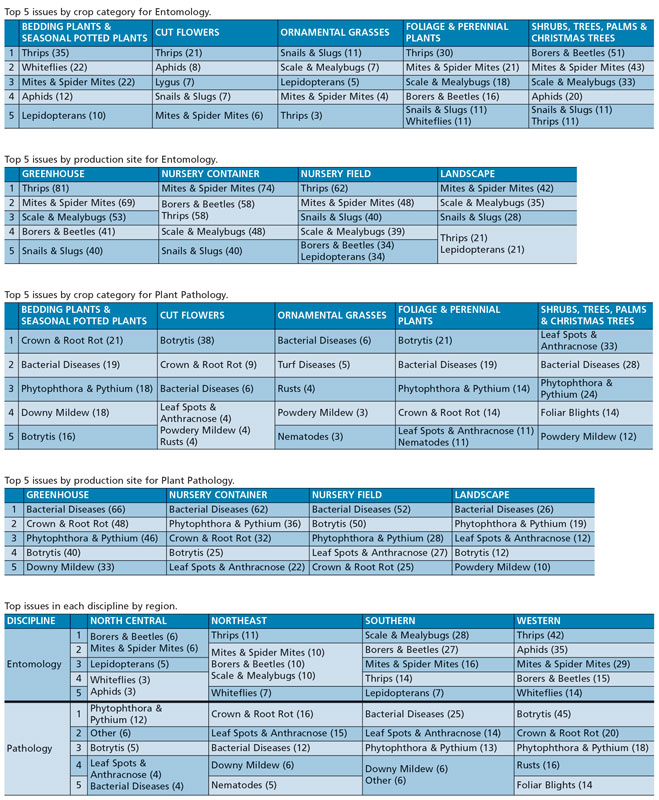2/1/2020
Setting Priorities
Compiled by Jennifer Zurko, with JC Chong & Dr. Jill Calabro

For those of you who aren’t familiar with what IR-4 is or does, it’s a project that was established way back in 1963 between the USDA, the National Institute of Food and Agriculture (NIFA), the Agricultural Research Service (ARS), the EPA, agrichemical groups and growers.
The original goal, which is still its main function today, is to facilitate regulatory approval of sustainable pest management technology for environmental horticulture crops to promote public health and well-being. IR-4 facilitates national and regional research projects to develop efficacy and crop safety data so that new biological and chemical active ingredients can be registered and current products expanded for new uses. Administered by USDA NIFA, the programs within IR-4 are federally funded by the government.
Specialty crops served by IR-4 include fruits and vegetables, tree fruits, dried fruits, horticulture, and floriculture and nursery crops. A recent economic analysis conducted by Michigan State University estimates that “IR-4’s partnership with agriculture has contributed to 95,261 jobs with a total labor income of $5.6 billion and annual contributions to the gross domestic product totaling $9.4 billion.”
A group of plant pathologists, entomologists and weed scientists meet biannually to set research goals based on current needs, with the last meeting this past fall in 2019. At the meeting, researchers and representatives of growers, pesticide manufacturers and distributors gathered to discuss the major pest and disease issues faced by the green industry, identify research priorities for the next two years, and develop approaches to achieve these priorities and goals.
A tool the meeting attendees used to identify research priorities was the Grower Survey conducted by IR-4 in 2018-19. The pest and disease issues identified as the top priorities by the Grower Survey are often selected as research priorities.
Some interesting demographic statistics that came out of the survey were:
• Over 60% of the survey respondents were growers, and those who work in greenhouses, container nurseries and field/in-ground nurseries made up the largest groups at roughly equal proportions (21% to 24% each)
• These growers produce a variety of horticultural crops, with bedding plants, perennials, shrubs and trees being the major products (11% to 14% each)
• The largest chunk of the respondents hailed from the West (46%), followed by the South (26%), Northeast (18%) and North Central (11%)
The major pest problems listed in order of importance were:
• Thrips—Identified as the most important pest in greenhouse and field nurseries, and for bedding plants, seasonally potted plants, cut flowers, foliage plants and perennials
• Mites and spider mites
• Borers and beetles—The biggest issues for trees and shrubs, as are snails and slugs for ornamental grasses
• Scales and mealybugs
• Aphids
The top five diseases growers listed are bacterial diseases:
• Botrytis—The most important
issue on cut flowers, foliage plants and perennials
• Phytophthora and pythium
• Leaf spots and anthracnose—Most important for shrub and tree growers
• Crown and root rots—Important to bedding plant producers
The top five weeds are:
• Perennial broadleaves—The most important issue for all production sites
• Summer annual broadleaves
• Grasses, horsetail and similar weeds—Mostly for cut flower producers
• Liverworts
• Moss and algae
In late 2019, USDA NIFA announced the renewal of IR-4 Project’s funding in the amount of $11 million to continue to generate additional data for registration of conventional and bio-based crop protection tools for specialty and minor crops in the U.S.
Increased funding for the IR-4 Project was a key focus at AmericanHort’s recent Impact Washington Summit in September 2019. Additional funds would enable the IR-4 Project to be restored to full capacity, replace obsolete research equipment and expand field trials. GT

New Research Priorities Set for the IR-4 Project
IR-4 set priorities at its biannual meeting in Fall 2019 for research needed over the next two years, 2020 and 2021.
Priorities on both a national and regional level were set for the Environmental Horticulture Program.
National priorities
• Plant Pathology
Control of Pythium
Control of non-Oomycete root and crown rots
• Entomology
Control of borers and beetles
Control of mealybug and scale insects
• Weed Science
Crop safety of preemergent products
Control of Nostoc on hard surfaces
• Biopesticide
Control of powdery mildew on greenhouse potted plants
Control of root knot nematodes
Regional priorities
• North Central
Control of ambrosia beetles
Control of root knot nematodes
• Northeast
Improving directions for use with fatty acid herbicides
Control of outdoor thrips populations
• Southern
Control of European pepper moth
Control of bacterial leaf spots and blights
• Western
Control of liverwort
Control of Botrytis on peony
—Dr. Jill Calabro